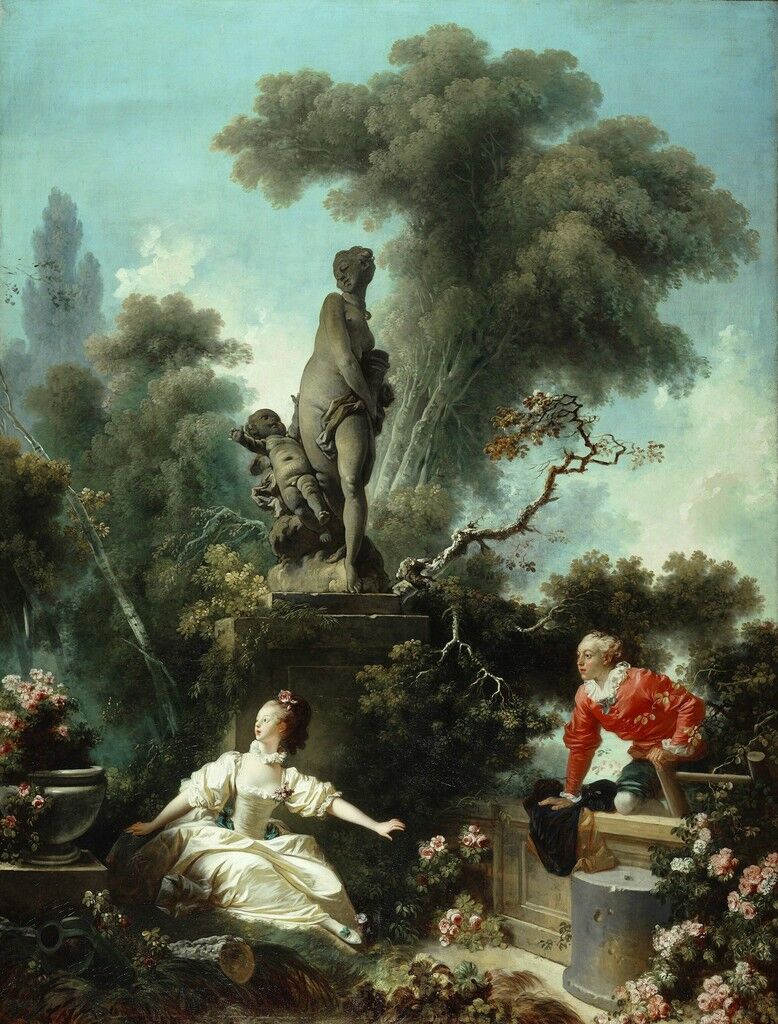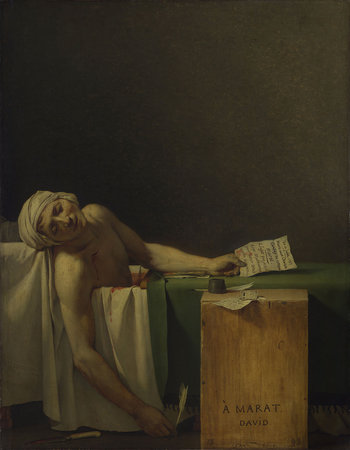Morality in Art of the Classical Era Exhibit
"Art must have grandeur and moral purpose" -Jacques Louis David
There are two distinct styles in the Classical Era: Rococo and Neoclassical. Rococo style originated in early 18th century Paris (Trapasso). It can be categorized by pastel colors, light subject matter, and fetes galantes. Fete galantes was created by the “father of Rococo painting” Jean Antoine Watteau (Trapasso). It is a category of painting, which includes scenes of “courtship parties” (Trapasso). Watteau was inspired by “scenes of everyday life that were quite popular in Flanders and the Netherlands” (Trapasso). These figures were usually gathered in outdoor spaces, exchanging pleasantries and enjoying music, while they were elegantly dressed (Trapasso). With the development of intellectual ideals from the Enlightenment, Rococo ideas of “frivolity and elegant eroticism became less and less relevant” (Trapasso). Due to this shift in intellect came the style Neoclassical art. Rococo art was much different than Neoclassical. Neoclassical art “brought about a general revival in classical thought that mirrored what was going on in political and social arenas of the time” (Unknown). Neoclassicism was inspired by the “discovery of ancient Greek and Roman archaeological sites and artifacts that became known throughout Europe'' (Unknown). Neoclassical art was the “return to the study of science, history, mathematics, and anatomical correctness abounded” which replaced “the Rococo vanity culture and court-painting climate that preceded” (Unknown). Neoclassical art leaned more towards moral subject matter that had meaning rather than Rococo art that had decorative subject matter with no deep meanings.

Background
This painting is called Pilgrimage to the Isle of Cythera by Jean-Antoine Watteau. It was painted in 1717 and originated in Musée du Louvre, Paris. This painting was created by the father of Rococo himself and stands true to the meaning of fetes galantes. Watteau submitted this painting to the French Royal Academy of Painting and Sculpture as an entry piece to "gain admission to the prestigious institution"(Singer).The French Royal Academy had never seen such a painting. They only "knew of history paintings, Biblical scenes, and still-lifes, but what this theme?" (Singer). The French Royal Academy even created a new painting genre for Watteau, so he could be a new academic member.Appreciation
This painting is done in rococo style of being elegantly dressed and outdoors. What is remarkable about this painting is not only the overly dressed subjects but what it is that they are doing. Upon further inspection of this piece the artist Watteau "captures the frivolity and sensuousness of Rococo painting, but it also captures the stages and growing nature of love" (Singer). Rococo is light subject matter without having a deep meaning, but most importantly "canvases were adorned with cherubs and myths of love, while keeping with the jocular trend of the period, portraiture was also popular"(All That's Interesting). The overall look is quite busy, one can't seem to focus their eyes long enough to see the different stages of love. When you look at this piece as a whole, you will see the curving lines, repetitive pink fleshy color, blues in the clothing, and this fog like haze in the back. To the right there is a lonely statue of Aphrodite. Aphrodite is said to be the goddess of love. The statue is "overlooking all who visit her island" and "blesses all visitors with love and affection" (Singer). 

There are three couples seen in this painting that are closest to the statue of Aphrodite: The first stage of the lovers are the couple with the lady wearing a pink dress. The couple is engaged in conversation. The man's blue cape has a heart on the shoulder."It symbolizes his love-struck intentions with this young lady" (Singer). Next is the Second couple with the lady wearing the blue dress. They represent "the second stage of courtship – surrender" (Singer). It is this the glance of the man as he lifts up the lady. Though we can't see her face, her body language suggests that she is smitten by this man as well allowing him to help her up off the ground.
Background
This painting is called "The Progress of Love: The Meeting" by Jean-Honoré Fragonard. It was made in the year 1771–3. This painting was commissioned by Madame du Barry. She wanted Fragonard to create a "decorative cycle for a new pavilion in the garden of her château at Louveciennes" (Unknown). Apparently, after the four canvas series was finished she rejected them for another style of art by Joseph-Marie Vien (Unknown). Appreciation
The meeting is another example of rococo style art. The woman seen in the painting is dressed elegantly outside with who I assume to be her lover. The look out both their faces shows a bit of shock as if they had just been discovered by someone. Fragonard "builds this dramatic tension in a painterly love triangle formed by the couple and the statue of Venus taking Cupid’s quiver of arrows that towers above them" (Unknown). I agree that "despite its somewhat staged nature, the scene is spontaneous and sweet without being saccharine" (Unknown). The color choices are very soft color palettes with contrasting vibrant shades of red, blue pink,and green. What stood out the most to me wasn't the lovers but the statue above them. It is very detailed and stood almost 3 dimensional compared to the rest of the painting. At first, I thought it was a real statue until i saw the rest of the painting. The painting itself embodies "the carefree pastoral charm of the Rococo and pre-Revolutionary French art" (Unknown).
This painting is called Death of Marat by Jacques-Louis David. It was created using oil on canvas in the year 1793. It was during the height of the Reign of Terror in 1793, when David painted a "memorial to his great friend, the murdered publisher, Jean Marat" (Khan Academy). The Death of Marat, is an "idealized image of David's slain friend, Marat" shown "holding his murderess's letter of introduction" (Khan Academy). Furthermore, David’s depiction was used as "Jacobin propaganda" because Marat was assassinated during the Reign of Terror (White). Charlotte Corday is said to be the coprate. She "gained entrance to his house by promising to give Marat dirt on enemies of the Revolution, then stabbed him"(White). Also, the note in Mara's hand is meant as "evidence of Corday’s trickery, showing a message from her asking for his help"(White).
Appreciation
David chose to make a political statement in this piece. There is a bloody knife on the floor "having opened a fatal gash that functions, as does the painting's very composition, as a reference to the entombment of Christ and a sort of secularized stigmata" (Khan Academy). This apparently references the wounds that Christ is said to have received on his hands, feet and side while on the cross (Khan Academy). Not only is this piece dark in subject matter it does symbolize morality that can be depicted from Neoclassical art. This image to me is a sign for justice to shed light on a tragic incident to seek out justice. Neoclassical art had a deeper meaning. David shed light on a political manner that was happening during that time which embodies neoclassicism. He created a powerful message through this painting without going overboard. The lines are soft yet are precise, the color palette consists of cooler toned colors. The background is plain to create Marat as the focal point, and David took the guess work out when he added Marat's name to the box right of his fallen hand. What is really striking to me is the pen in Marat's hand. Is it he who wrote the note or Charlotte? If it was him it shows how he used that last bit of life left to bring down his assassin.References
Trapasso, Erica. “A Brief History of Rococo Art.” Artnet, 2013, https://news.artnet.com/market/a
briefhistory-of-rococo-art-32790. Accessed 14 March 2021.
Unknown. “Summary of Neoclassicism.” theartstory, 2021, https://www.theartstory.org/movement/neoclassicism/history-and-concepts/.
Trapasso, Erica. A Brief History of Rococo Art https://news.artnet.com/market/a-brief-history-of-rococo-art-32790
Theartsotry. Summary of Neoclassicism https://www.theartstory.org/movement/neoclassicism/
All That's Interesting. The Rococo Art Movement That Dominated The Seventeenth & Eighteenth Century https://allthatsinteresting.com/rococo-art-movement
Khan Academy. David and The Death of Marat https://www.khanacademy.org/humanities/renaissance-reformation/rococo-neoclassicism/neo-classicism/a/david-and-the-death-of-marat
Singer, James. Painting of the Week: Jean-Antoine Watteau, Pilgrimage to the Isle of Cythera https://www.dailyartmagazine.com/painting-of-the-week-jean-antoine-watteau-pilgrimage-to-the-isle-of-cythera/
Theartstory. Summary of Rococo https://www.artsy.net/article/artsy-editorial-10-artworks-defined-rococo-style
White,Katie. "‘The Death of Marat’ Defined the French Revolution. Here Are 3 Things You Might Not Know About Jacques Louis David’s Masterpiece" https://news.artnet.com/exhibitions/jacques-louis-david-death-of-marat-3-facts-1894240





Thank you for sharing these diverse pieces. The piece by the Father of Rococo seems to be so full of joy. The part I enjoy the most are the brush strokes and how they seem to blend together with each piece within the painting. It is as if there is no separation between the subjects of the painting and their surroundings. The Death of Marat is quite the contrarian to the Rococo style of art. I find it haunting yet empowering to see such beautiful art that was inspired by tragedy. I am grateful for the work that is presented, but the context behind the art makes me upset. I suppose that is why I enjoy Rococo art more than Neoclassical. I find that Neoclassical art is political in a way that shows the ugliness in humanity such as acts of murder and violence. I prefer the way that Rococo tells a new idyllic story and not the way that Neoclassical is a newspaper of sorts that broadcasts the latest headlines.
ReplyDelete